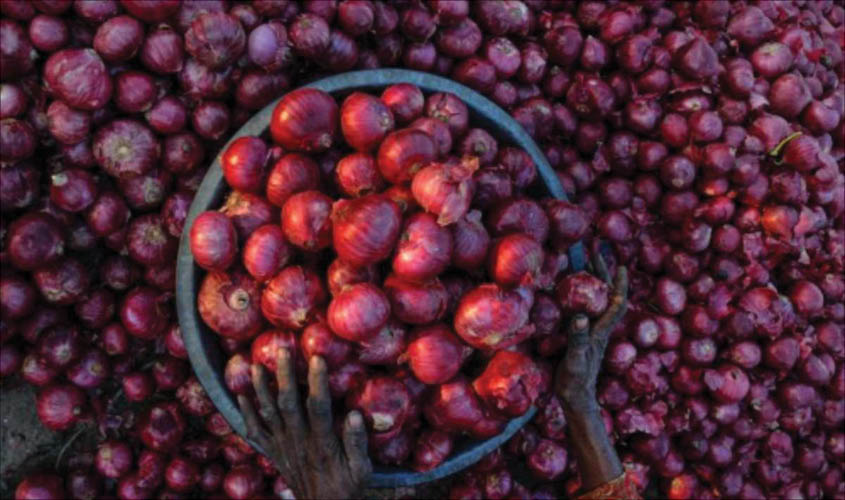Onion politics contrary to economic principle
The humble onion—the staple diet in almost every Indian household—has given sleepless nights to our netas who have shed onion tears in the past seeing their governments fall. And with two crucial state elections, BJP knows only too well the importance of rising kitchen bills due to the bulb. But successive Indian governments have failed the Indian farmer without addressing the real issue. And the present regime is also indulging in just that—quick fixes, even if it means serious damage to the interests of farmers.
Onion has two crops, one is the main Rabi crop which comes in April-May where typically a bumper crop leads to a massive decline in prices; second, is the Kharif crop which comes in September-October (there is also a late Kharif crop with a small produce). In peak season, prices are so depressed that farmers are forced to sell their produce below costs. In summer, onions sell at as low as Rs 6-7/kilo, even as costs range between Rs 9-11 per kilo. It is in the months of October-November when prices start rising that farmers hope to recover their costs and earn. But that is when prudent economics gets defeated by prudent politics.
Not every farmer has access to resources to store and it is only the large farmers with funding, logistics and storage facilities who wait out the peak season. Small marginal farmers suffer the most (some commit suicide due to high levels of indebtedness) as they continue to sell below costs, one of the reasons why farming is unsustainable in India.
Even the storage facilities that exist are grossly imperfect, leading to a substantial loss of crop, which could be anywhere between 20-25% depending on the vagaries of nature. Kanda chawls present all over Maharashtra are crude warehouses and are totally ill-equipped in times like the extraordinary rains that the state witnessed this year, hitting the overall produce.
So prices, typically, rise every year around this time as farmers (the big, wealthy and organised ones) make money.
But unhappy housewives wailing on TV screens about onion prices hitting kitchen economics right in the middle of an election season make for dramatic visuals forcing political interventions that are mostly contrary to sound economics—something successive governments are guilty of.
This year, the problem has been further compounded by a lengthy monsoon—instead of 1 September, the monsoon withdrawal began from 9 October. This has been the most delayed monsoon ever and unseasonal rains have ruined large onion produce in Maharasthra, Karnataka, MP, UP and Gujarat.
Maharashtra and Karnataka top two onion producers in India, accounting for 38% and 12% of the total production respectively. While Maharashtra received 1.5 times the normal rain this year, for Karnataka, rainfall was 65% in excess. This added to the woes of both farmers and consumers with lower produce hitting the markets leading to an abnormal price rise.
Export curbs, higher imports, minimum export prices and minimum stock limit are all tried and tested measures that immediately kick in when prices start rising to subsidise the Indian urban consumer at the cost of the Indian farmer. Nothing has changed in our standard response. In 2010, onion prices reached Rs 90/kg and the Manmohan Singh government banned onion exports. Never mind that India is one of the largest exporters of the vegetable. As per DGCIS report, we exported nearly 2 million tonnes in 2018-19 with value of Rs 3,000 crore. In fact, Lalsagaon in Nashik is Asia’s largest onion wholesale market.
A minimum export price has also been introduced, in a clear effort to make Indian exports noncompetitive that will eventually mean a larger produce making its way in domestic market. Setting a floor price of around $850-900/tonne means a price of Rs 60-65/ kilo. Obviously, this will mean Indian farmers lose out to other nations selling onions cheaper. The same logic applies to large volumes of imports from other countries.
So what does this all add up to? It means farmers suffer when prices go down (in peak season in May) and they suffer when prices go up (in lean season in September-October-November). So while the vegetable goes through a cycle of boom and bust, the farmer goes through endless cycles of bust and bust.
Add to this the fact that a disproportionate amount of the gains from price rise accrue to retailers. Back-of-the-envelope calculations suggest retailer margins are maximum—at 20%, sometimes even 25%.
What we need is a scientific method of storage and entry of large-scale cold chains and a regular retail system where prices can be regulated to ensure stability and consistency and above all, gains from price rise accrue to farmers. Farm-to-fork is a long, long journey in India that ends up hurting farmers the most, benefiting retailers with political and financial muscle the most.
But it is the potential of the humble onion to make or break political careers that makes political intervention hard to resist. From Indira Gandhi in 1980 who launched a campaign against the Janata Party government to Sheila Dikshit who became Delhi Chief Minister in 1998 defeating BJP due to soaring onion prices, to 2013 when the then economist-PM looked ineffective in dealing with high onion prices, the bulb has for long been seen as the barometer of political mood. But bad economics also haunt politicians.
In a polity focused entirely on “annadata”, it is ironic his interests contradict policies. Wailing middle class housewives can wait, highly-indebted farmers cannot.
Gaurie Dwivedi is a senior journalist covering economy, policy and politics.

